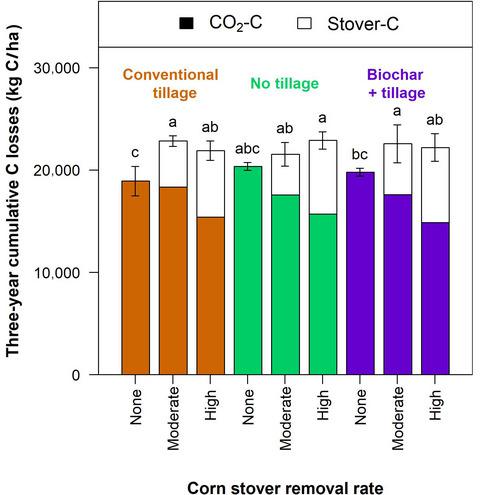当前位置:
X-MOL 学术
›
GCB Bioenergy
›
论文详情
Our official English website, www.x-mol.net, welcomes your
feedback! (Note: you will need to create a separate account there.)
Corn stover harvest reduces soil CO2 fluxes but increases overall C losses
Global Change Biology Bioenergy ( IF 5.9 ) Pub Date : 2020-08-13 , DOI: 10.1111/gcbb.12742 Peter L. O’Brien 1 , Thomas J. Sauer 1 , Sotirios Archontoulis 2 , Douglas L. Karlen 3 , David Laird 2
Global Change Biology Bioenergy ( IF 5.9 ) Pub Date : 2020-08-13 , DOI: 10.1111/gcbb.12742 Peter L. O’Brien 1 , Thomas J. Sauer 1 , Sotirios Archontoulis 2 , Douglas L. Karlen 3 , David Laird 2
Affiliation

|
Harvesting corn (Zea mays L.) stover for use as bioenergy feedstock may provide short‐term economic benefits and perhaps improve grain yield in continuous corn systems, but excessive stover removal may lead to long‐term depletion of soil C stocks. To better quantify the impacts of stover harvest on the soil C balance, we investigated CO2 fluxes under three harvest treatments (none, moderate, and high) in three continuous corn systems: (a) no tillage and no biochar applications, (b) chisel plowing with biochar amendments, and (c) chisel plowing without biochar amendments were quantified. We sampled static chambers 14, 13, and 15 times in 2010, 2011, and 2012, respectively, and the measurements were used to calibrate the Agricultural Production Systems sIMulator model. Although CO2‐C emissions did not differ among the three systems, both moderate (approximately 30%) and high (approximately 60%) stover removal rates reduced simulated CO2‐C emissions by nearly 10% and more than 22%, respectively. Despite these reductions in CO2 flux, the sum of CO2‐C and stover C exceeded CO2‐C losses in those plots without stover removal. This finding suggested soil C depletion was occurring for the soil and crop management practices used, even though depletion was not evident after 3 years. Application of biochar increased soil C levels, suggesting it may be able to offset some C losses. We conclude that for sustainable, highly productive agroecosystems that include stover harvest, all agronomic practices must be optimized to minimize C losses and maintain soil quality.
中文翻译:

玉米秸秆收获减少了土壤CO2通量,但增加了总体碳损失
收获的玉米(玉米L.)秸秆用作生物能源的原料可以提供短期的经济利益,并可能提高玉米连续系统的粮食产量,但秸秆清除过多可能会导致土壤碳库的长期消耗。为了更好地量化秸秆收割对土壤碳平衡的影响,我们在三种连续玉米系统的三种收割处理(无,中,高)下调查了CO 2通量:(a)免耕和无生物炭施用,(b)对带有生物炭修饰物的凿子犁耕和(c)没有生物炭修饰物的凿子犁耕进行了定量。我们分别在2010年,2011年和2012年分别对静态隔室进行了14、13和15次采样,并将测量结果用于校准“农业生产系统” simulator模型。虽然一氧化碳在这三个系统之间,2 C排放无差异,中度(约30%)和高(约60%)秸秆清除率分别使模拟CO 2 -C排放降低了近10%和22%以上。尽管减少了CO 2通量,但CO 2 ‐C和秸秆C的总和仍超过了CO 2在没有拆除秸秆的情况下,这些土地的C损失。这一发现表明,尽管所用的土壤和作物管理方法在3年后没有明显减少,但在土壤和作物管理实践中土壤C的消耗却正在发生。生物炭的施用增加了土壤的碳水平,表明它可能能够抵消一些碳损失。我们得出结论,对于包括秸秆收割在内的可持续,高产农业生态系统,必须优化所有农艺实践,以最大程度减少碳损失并保持土壤质量。
更新日期:2020-10-15
中文翻译:

玉米秸秆收获减少了土壤CO2通量,但增加了总体碳损失
收获的玉米(玉米L.)秸秆用作生物能源的原料可以提供短期的经济利益,并可能提高玉米连续系统的粮食产量,但秸秆清除过多可能会导致土壤碳库的长期消耗。为了更好地量化秸秆收割对土壤碳平衡的影响,我们在三种连续玉米系统的三种收割处理(无,中,高)下调查了CO 2通量:(a)免耕和无生物炭施用,(b)对带有生物炭修饰物的凿子犁耕和(c)没有生物炭修饰物的凿子犁耕进行了定量。我们分别在2010年,2011年和2012年分别对静态隔室进行了14、13和15次采样,并将测量结果用于校准“农业生产系统” simulator模型。虽然一氧化碳在这三个系统之间,2 C排放无差异,中度(约30%)和高(约60%)秸秆清除率分别使模拟CO 2 -C排放降低了近10%和22%以上。尽管减少了CO 2通量,但CO 2 ‐C和秸秆C的总和仍超过了CO 2在没有拆除秸秆的情况下,这些土地的C损失。这一发现表明,尽管所用的土壤和作物管理方法在3年后没有明显减少,但在土壤和作物管理实践中土壤C的消耗却正在发生。生物炭的施用增加了土壤的碳水平,表明它可能能够抵消一些碳损失。我们得出结论,对于包括秸秆收割在内的可持续,高产农业生态系统,必须优化所有农艺实践,以最大程度减少碳损失并保持土壤质量。











































 京公网安备 11010802027423号
京公网安备 11010802027423号